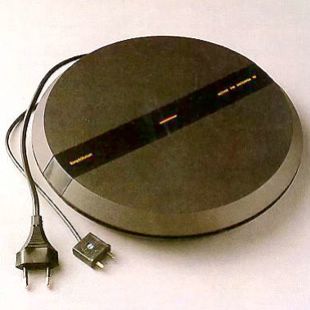Active AM Antenna 10

Manufactured: 1986 - 1993
Designer:
Colours: Black
The oldest programme source for electronic equipment in the home is AM radio reception on Long and Medium wavebands. Yet despite its long history, achieving a satisfactory sound quality from AM can still be problematic because of inadequacies in the first link of the reception chain - the AM aerial.
The simplest way to receive any radio transmission is by means of a tuned aerial i.e. a wire measuring half the length of the radio waves you want to capture. This is quite easy with FM broadcasts because of the relatively short wavelengths used i.e. around 1.5 metres in the middle of the FM band. But as AM broadcast wavelengths can vary between 787 and 2000 metres, a tuned "half-wave" antenna would ideally need to be longer than two laps of an Olympic race track, and have some means off adjusting its length according to which station we want to hear.
Hardly a practical proposition! An AM transmitter emits both an electrical and magnetic field. Both these fields can to a degree, penetrate most solid objects such as walls, so we can choose either fields as our signal source.
The half-wave tuned aerial uses the electric field. Its more manageable alternatives - the 10-15 metre long capacitive roof-top or smaller indoor aerial - also relies mainly on the electrical field. Wire aerials like these do not have a pronounced directivity but pick up from all points of the compass. Consequently, they will also pick up unwanted electrical fields from other sources, so an indoor wire aerial is very sensitive to the fields generated by fluorescent lights, kitchen appliances and other domestic equipment. These spurious signals are reproduced by the radio as 'interference' and can seriously mar one's listening enjoyment.
But what about the AM transmitter's other signal-source - the magnetic field? The simplest method of picking up these signals is via a coil. The efficiency of such a coil is increased by winding it around a ferrite core which 'sucks in' more magnetic lines to the coil. A device like this has a pronounced directivity, so the angle at which the aerial lies in relation to the transmitter determines how strongly it picks up the signal. Maximum signal strength is obtained when the magnetic lines run lengthwise along through the ferrite rod or core i.e. when the aerial is broadside on to the transmitter. When the aerial is end-up to the transmitter, signal reception is minimised.
This directivity can be useful. It allows the listener to reject very strong signals from a nearby transmitter in favour of a weaker, more distant station. Careful positioning of the aerial can also reduce the field effects of other household equipment, although this problem is less critical than with the capacitive wire aerial because most noise sources produce a far weaker magnetic field than an electric field.
However, a ferrite aerial cannot properly if surrounded by metal, so if placed inside the radio it would be screened by metal cabinet parts and other internal components. Many manufacturers attach a ferrite rod to the back of their receivers, but even here it is screened on one side and is rarely fully manoeuvrable due to space limitations.
Bang & Olufsen's solution was the Active AM Antenna 10 (type 2037), an accessory that could be used with all Beocenters and Beomasters covering LW and MW bands. The technique which the Active Antenna employed was new and design patents were applied for at the time.
Inside the neat, unobtrusive disc were two ferrite-rod aerials and an amplifier. The two aerials were precision-coupled to 'flatten out' the signal amplitude across the entire frequency range and eliminate the need for the variable components which, in conventional designs, have to be adjusted manually when changing from one station to another.
The directivity of the Active Antenna was superb. It was found invaluable of areas of difficult reception where it could be rotated to minimise noise sources of unwanted stations, ensuring clean, clear reception from previously 'mushy' transmitters. Its sensitivity was comparable to a good rooftop aerial, yet it took up little space, needing no permanent fixing and could be independently sited on any shelf or, if reception conditions permitted, hung on the wall.
The Bang & Olufsen Active Antenna 10 was connected to the AM socket of a Beomaster or Beocenter and to the mains. Power consumption was only 2 watts, so the antenna could be safely left permanently switched on. It required no day-to-day operation or maintenance.
Active AM Antenna 10 Product Specifications
Power output LOOP 15 watts / 0.5 ohms
Power output MINI LOOP 0.82 watts / 82 ohms
Distortion 0.3 %
Frequency range Adapted to norm for hearing aids
Signal-to-noise ratio 55 dB
Line input 0 - 500 mV Radio input 0 - 10 mV
Loop area (Room area) Max 50 m2
Power consumption Max 32 W
Power consumption, TV and radio off 4 W
Power supply 220 V
Dimensions (W x H x D): 12 x 65 x 19cm
Weight: 1.7kg
Related Products
- BeoMaster 5000 Tuner/Amplifier
- BeoMaster 5500 Tuner/Amplifier
- BeoMaster 6500 Tuner/Amplifier
- BeoMaster 7000 Tuner/Amplifier
- BeoCenter 8000
- BeoCenter 8500
- BeoCenter 9000
- BeoCenter 9300
- BeoCenter 9500
Created: 17th February 2007
Modified: 18th February 2007
Author Notes:




